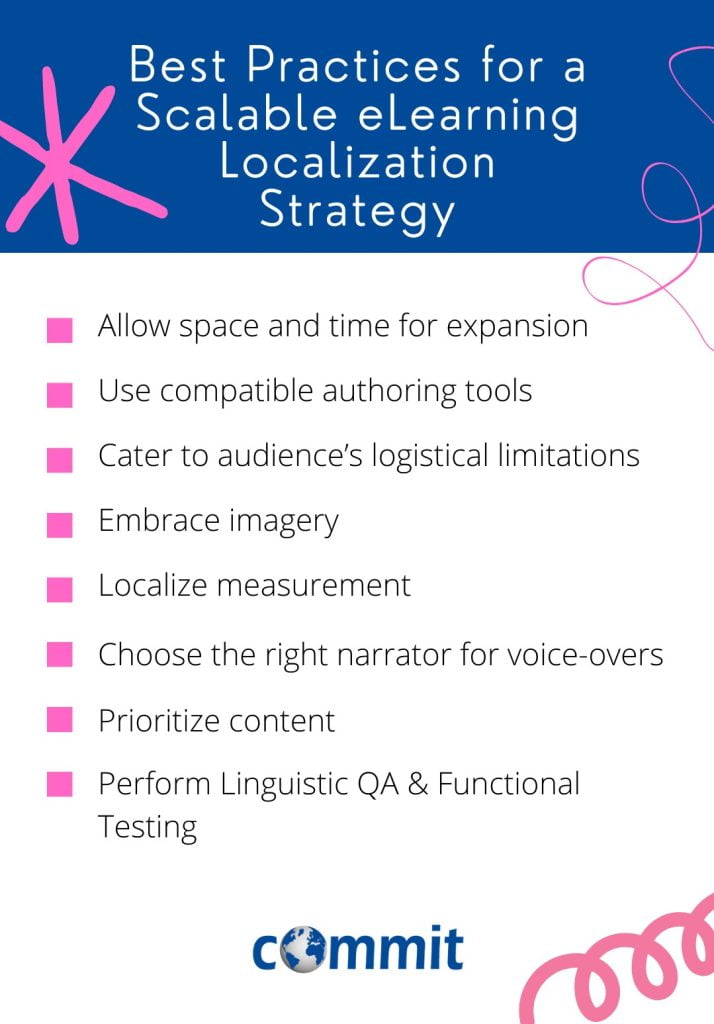|
Listen to Post
|
Listen to this article now:
A scalable eLearning localization strategy maintains a high standard of quality while meeting time and cost restrictions.
While culture and language are unique and require a customized approach to translation and localization, several best practices ensure clear, engaging, and effective learning materials in every workplace environment.
Here are the must-know best practices for a successful, scalable eLearning localization strategy:
Allow space and time for expansion
Some languages are wordy and can take anywhere between 30 to 50 percent more space than the English version. So be proactive at the initial design level and provide enough physical space for text expansion. If there have to be character limitations, let your localization partners know what the maximum allowed number of characters is and consult with them for the best approach. Also, allow extra time for reading before displaying the next block of text on the screen. In case of software, apps or websites, consider using dynamic and responsive design.
The same issue with expansion also applies to voiceovers. Some languages will take up more time during the recording so leave ample time for audio expansion to cater to these languages.

Use compatible authoring tools
Ensure the authoring tools you use to create your course can be easily exported into a .doc, .docx, or XML file type – these formats are widely accessible and supported by the software translators use. Recommended authoring tools for eLearning materials include Adobe Captivate, Lectora, and Articulate Storyline.
Cater to your audience’s logistical limitations
There is more to successful global eLearning than meeting cultural and language needs – cater to your audience’s logistical limitations, too.
Are there any roadblocks you must work around specific to their geographic location? What about available technology? Do they have a fast and reliable Internet connection that can handle video?
Also, what device will they be using to access your course? A computer, tablet, or smartphone? More than half of all web traffic comes from smartphones, indicating that the world’s population favors and has greater access to mobile devices. So, while you should not discount the needs of desktop users, make sure that your content is comfortable to read and engage with on mobile.
It doesn’t matter how well you’ve localized your content if your audience can’t access it.
Embrace imagery
You have heard the cliché, ‘A picture is worth a thousand words.’ Embrace it in your learning materials. Images, graphics, and graphs are strong cross-cultural communication tools that audiences around the globe can recognize and absorb near-instantly – the human brain processes images 60,000 times faster than text.
When choosing images, aim for neutrality. Try to opt for neutral images of people, humanoid images or vector images.

Localize measurement
Training employees without measuring their progress is like driving blind. So, as you develop your eLearning localization strategy, make sure to also adapt both quantitative and qualitative measurement methodologies and metrics. Ideally, metrics should be consistent across all regions your company operates in to allow for benchmarking, employee group comparison, and the identification of knowledge gaps. Key performance metrics include completion rate, engagement, learner feedback, and test results.
Choose the right narrator for voice-overs
It is very important to know that in some cultures, as in the Middle-East and South Asia, people expect the voice of the narrator to be very authoritative and firm. In other cultures, as in Western countries, people would expect a friendly, informal tone. Make sure your narrator sounds professional for the intended audience.
Invest in a style guide and glossary
The style guide defines the style, terminology and conventions from the beginning and provides uniformity in style and formatting throughout your eLearning and training documentation, but also across company initiatives and products. It improves the quality of your translations, minimizes inconsistencies, adds professionalism to your work and saves time and money.
Prioritize content
The Pareto Principle, also called the 80-20 rule, suggests that 80 percent of your outputs result from 20 percent of your inputs. In a learning environment, it asserts that in most cases, 20 percent of the training content achieves 80 percent of the desired outcome.
How does this impact your company’s approach to its localization strategy for training? It merely suggests prioritizing content! Localize the most important content first, to deliver a high-quality product that better meets regional needs faster. Focus on the content that is most crucial for your employees’ training, in order to get the quickest return on your investment.

Perform Linguistic QA & Functional Testing
Whether we are talking about an eLearning course, a PowerPoint presentation or a subtitling or voice-over project, the linguistic sign-off (and/or functional testing) is an integral step in the localization process. It should be performed by trained localization QA professionals that are native in the target language and it will help to expose possible technical issues related to text sizing and truncation, hard-coded strings and character corruption. This final step also gives the linguist the chance to actually see the translation in full context and in its final form and perform any necessary last-minute changes.
Next Steps
If you are ready to capitalize on growth opportunities offered by a globalized workforce, localization is the key to unlocking your teams’ potential.
When it comes to eLearning, translation alone is not enough. Regional differences go far beyond language. Cultural nuances and expectations influence not just what is said but how it is said and understood.
Contact the friendly team at Commit Global today to take the next step in your business’s international growth journey. We are equipped to deliver industry-leading eLearning content tailored to global audiences.

Read also:
What Is eLearning Localization? How Is It Different from Translation?
Closing the Corporate Communications Gap With Localization
7 Ways to Successfully Manage International Teams
Measuring the Localization ROI in Corporate Training
8 Tips for eLearning Localization
The Benefits of Localization for Your Global Training Strategy








